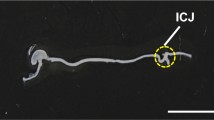Abstract
Whereas the understanding of the mechanisms underlying skeletal and cardiac muscle development has been increased dramatically in recent years, the understanding of smooth muscle development is still in its infancy. This paper summarizes studies on the ontogeny of chicken smooth muscle cells in the wall of the aorta and aortic arch-derived arteries. Employing immunocytochemistry with antibodies against smooth muscle contractile and extracellular matrix proteins we trace smooth muscle cell patterning from early development throughout adulthood. Comparing late stage embryos to young and adult chickens we demonstrate, for all the stages analyzed, that the cells in the media of aortic arch-derived arteries and of the thoracic aorta are organized in alternating lamellae. The lamellar cells, but not the interlamellar cells, express smooth muscle specific contractile proteins and are surrounded by basement membrane proteins. This smooth muscle cell organization of lamellar and interlamellar cells is fully acquired by embryonic day 11 (ED11). We further show that, during earlier stages of embryogenesis (ED3 through ED7), cells expressing smooth muscle proteins appear only in the peri-endothelial region of the aortic and aortic arch wall and are organized as a narrow band of cells that does not demonstrate the lamellar-interlamellar pattern. On ED9, infrequent cells organized in lamellar-interlamellar organization can be detected and their frequency increases by ED10. In addition to changes in cell organization, we show that there is a characteristic sequence of contractile and extracellular matrix protein expression during development of the aortic wall. At ED3 the peri-endothelial band of differentiated smooth muscle cells is already positive for smooth muscle alpha actin (αSM-actin) and fibronectin. By the next embryonic day the peri-endothelial cell layer is also positive for smooth muscle myosin light chain kinase (SM-MLCK). Subsequently, by ED5 this peri-endothelial band of differentiated smooth muscle cells is positive for αSM-actin, SM-MLCK, SM-calponin, fibronectin, and collagen type IV. However, laminin and desmin (characteristic basement membrane and contractile proteins of smooth muscle) are first seen only at the onset of the lamellar-interlamellar cell organization (ED9 to ED10). We conclude that the development of chicken aortic smooth muscle involves transitions in cell organization and in expression of smooth muscle proteins until the adult-like phenotype is achieved by mid-embryogenesis. This detailed analysis of the ontogeny of chick aortic smooth muscle should provide a sound basis for future studies on the regulatory mechanisms underlying vascular smooth muscle development.
Similar content being viewed by others
Author information
Authors and Affiliations
Additional information
Accepted: 17 December 1997
Rights and permissions
About this article
Cite this article
Yablonka-Reuveni, Z., Christ, B. & Benson, J. Transitions in cell organization and in expression of contractile and extracellular matrix proteins during development of chicken aortic smooth muscle: evidence for a complex spatial and temporal differentiationprogram. Anat Embryol 197, 421–437 (1998). https://doi.org/10.1007/s004290050154
Issue Date:
DOI: https://doi.org/10.1007/s004290050154




